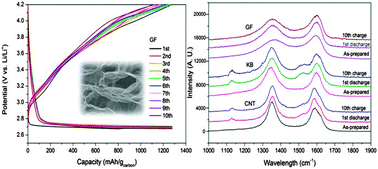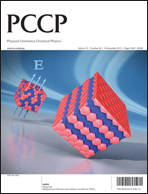Electrochemical properties of graphene flakes as an air cathode material for Li–O2 batteries in an ether-based electrolyte†
Abstract
We employed graphene flakes as an air-cathode material for Li–O2 batteries and investigated their electrochemical properties in the dimethyl ether electrolyte. Graphene flakes were prepared by microwave-assisted reduction of graphene oxide, and their electrochemical properties were compared with those of Ketjen Black and carbon nanotubes. The catalytic effect of the prepared graphene flake-air cathode was demonstrated using cyclic voltammetry and discharge–charge testing performed under a limited discharge capacity. The catalytic effect of graphene flakes was also supported by morphological and spectroscopic analysis of the discharge–charge products formed on the graphene surface. Scanning electron microscopy, X-ray diffraction, and Fourier-transform infrared spectroscopy revealed that Li2O2, Li2O, and Li2CO3 were the main discharge products on all carbon-air cathode surfaces. Raman spectroscopy revealed that LiRCO3 was additionally formed on Ketjen Black and carbon nanotubes during the first discharge; however, its formation was not observed on the graphene flakes. The catalytic effect of the graphene flakes and the absence of LiRCO3 in the discharge product could explain the higher Coulombic efficiency in the discharge–charge tests.


 Please wait while we load your content...
Please wait while we load your content...